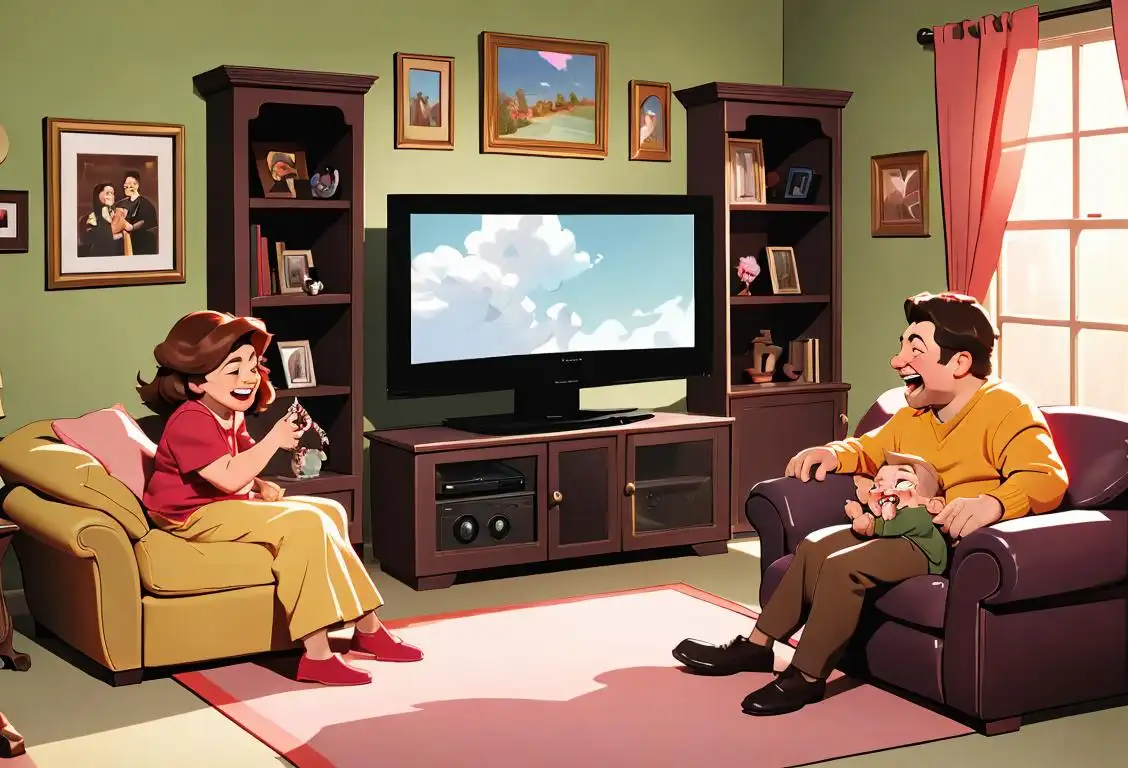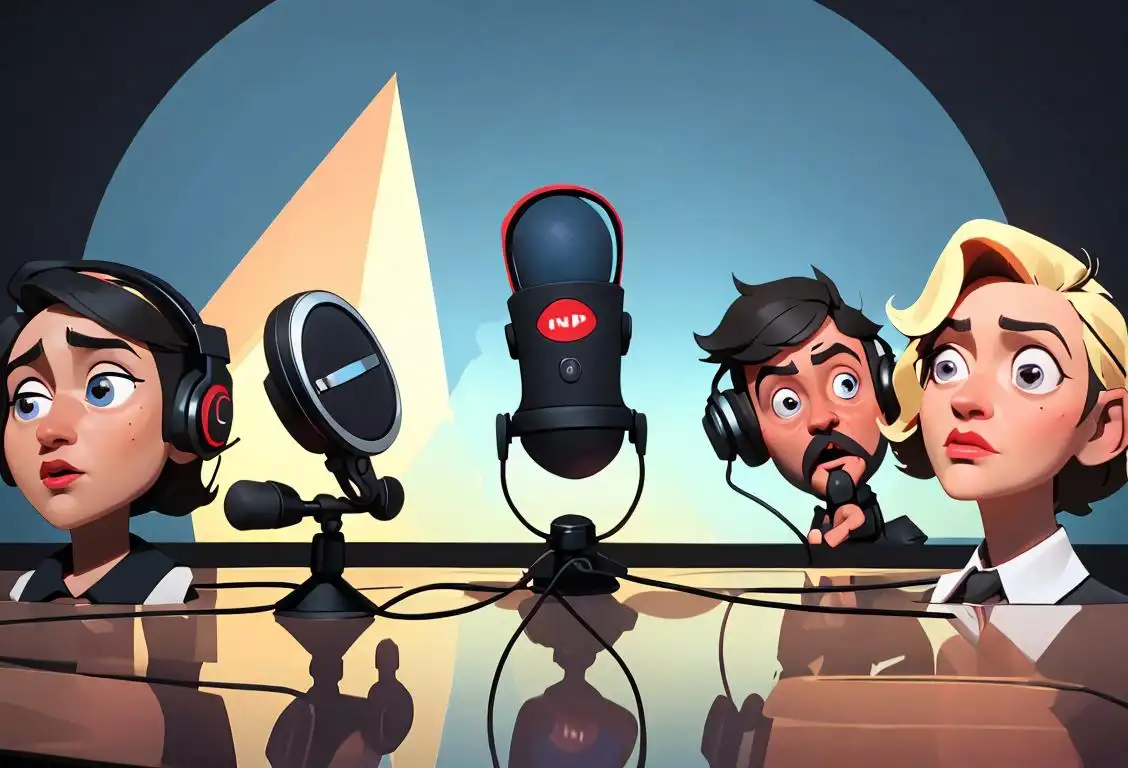National Broadcasting Day

Welcome to the wacky world of National Broadcasting Day! It's a day to celebrate all things related to the airwaves and the magical voices that entertain us. From radio to television to podcasts, this is the perfect day for anyone who loves to be entertained or wants to dive into the fascinating history of broadcasting. So tune in, sit back, and enjoy our guide to everything you need to know about National Broadcasting Day!
When is Broadcasting Day?
It's national broadcasting day on the 23rd July.
The Birth of the Airwaves
On this special day, we pay homage to the birth of broadcasting as we know it. It all began with the invention of the radio, which sparked a revolution in the way we connect with the world. The first radio broadcast took place on December 24, 1906, when Reginald Fessenden transmitted a Christmas Eve program from his experimental station in Massachusetts. From that moment on, the airwaves became a conduit for news, music, stories, and so much more.
The Golden Age of Radio
During the early 20th century, radio became an indispensable part of the American household. Families gathered around their trusty radio sets, eagerly tuning in to their favorite programs. From the thrilling adventures of The Shadow to the heartwarming storytelling of Little Orphan Annie, radio shows captivated millions with their vivid storytelling and unforgettable characters.
The Rise of Television
While radio ruled the airwaves for several decades, television came onto the scene in the 1940s and quickly stole the show. People could now not only hear but also see their favorite performers in the comfort of their own living rooms. TV shows like I Love Lucy, The Twilight Zone, and The Simpsons became cultural phenomena, shaping our sense of humor, imagination, and even our fashion choices!
The Emergence of Podcasts
In recent years, we've witnessed another broadcasting revolution with the rise of podcasts. These digital audio shows have given a voice to anyone with a microphone and a story to tell. Whether you're into true crime, comedy, or learning new skills, there's a podcast out there for everyone. National Broadcasting Day celebrates this new era of storytelling and the freedom it gives to creators and listeners alike.
Let's Celebrate!
So how can you celebrate National Broadcasting Day? Well, you can start by thanking all the broadcasters who have entertained you over the years. Send a heartfelt message to your favorite radio host, TV anchor, or podcast creator to let them know how much their work means to you. You can also tune in to your favorite radio station, binge-watch that TV series you've been meaning to catch up on, or explore new podcasts that pique your interest. Share your appreciation on social media using the hashtag #NationalBroadcastingDay and spread the word about the importance of broadcasting in our lives!
History behind the term 'Broadcasting'
1922
The birth of broadcasting
In 1922, broadcasting emerged as a term used for the transmission of audio signals to a wide audience. It originally referred to the process of sowing seeds over a wide area by scattering them broadly. The term was then adapted to describe the act of transmitting sound or visual content to a large number of listeners or viewers via radio or television waves.
1906
The Birth of Broadcasting
In the year 1906, the term 'broadcasting' was first coined by Reginald Fessenden, a Canadian inventor. Fessenden used this term when he successfully transmitted a broadcast of voice and music over a distance of several miles. This groundbreaking technological achievement marked the birth of broadcasting and laid the foundation for a revolutionary form of communication and entertainment.
1920
The Birth of Broadcasting
The term 'broadcasting' originated in the year 1920. It refers to the transmission of radio programs, speeches, music, and other types of audio content to a wide audience. The word 'broadcast' itself comes from the agricultural practice of scattering seeds over a broad area, as radio waves were metaphorically scattered over large regions to reach listeners.
1920
Birth of Electronic Broadcasting
In the year 1920, the concept of broadcasting took its first steps with the advent of electronic transmission. This marked a significant shift from the previous methods of communication, such as telegraph and telephone, which relied on point-to-point connections. With electronic broadcasting, information could be transmitted over the airwaves to a wide audience, enabling mass communication on a previously unimaginable scale.
1920
Birth of Broadcasting
In the early 1920s, broadcasting emerged as a revolutionary medium for mass communication. The term 'broadcasting' originated from the agricultural technique of spreading seeds by scattering them widely across a field. It was used metaphorically to describe the transmission of information or entertainment to a large and diverse audience through airwaves.
1909
First Use of the Term 'Broadcasting'
The term 'broadcasting' was coined by Lee De Forest, an American inventor, in 1909. De Forest used the term to describe the process of sending wireless telegraph signals to multiple receiving stations simultaneously. This marked the beginning of the term's association with the dissemination of information and entertainment to a wide audience.
1896
Invention of the wireless telegraph
In 1896, Guglielmo Marconi, an Italian inventor, successfully transmitted long-distance wireless signals using his invention, the wireless telegraph. This breakthrough technology paved the way for the development of broadcast communication.
1906
The Birth of Broadcasting
In 1906, the term 'broadcasting' originated to describe the act of transmitting messages over long distances using wireless technology. This marked a groundbreaking development in communication, as it allowed for the dissemination of information to a large audience regardless of their physical location.
1922
The Power of Radio
In 1922, radios started to gain immense popularity, and with it, broadcasting became a household term. Radios allowed people to tune in to various radio stations, which were the primary means of broadcasting at that time. The concept of broadcasting expanded beyond agriculture and became synonymous with the transmission of programs, news, and music through radio waves.
1920s
Early radio broadcasting
During the 1920s, radio broadcasting became popular, with radio stations broadcasting news, music, and entertainment to a growing audience. This marked the first mass medium for audio content and laid the foundation for the development of broadcasting as we know it today. The term 'broadcasting' became synonymous with radio transmission.
1920
Birth of Commercial Radio Broadcasting
In 1920, the first commercial radio broadcast took place in Pittsburgh, Pennsylvania. The station, KDKA, was run by Westinghouse Electric Corporation and transmitted the results of the presidential election to a large audience. This event marked a significant milestone in the history of broadcasting, as it showcased the potential for mass communication and entertainment through the radio medium.
1922
Radio as the Dominant Broadcasting Medium
In 1922, the term 'broadcasting' became synonymous with radio, as it rapidly gained popularity as the primary medium for mass communication. Radios became household appliances, and people tuned in regularly to listen to news, music, and entertainment. The term 'broadcasting' was specifically used to differentiate radio transmission from point-to-point communications like telegraph and telephone.
1920
The Rise of Commercial Radio Broadcasting
By the 1920s, broadcasting had evolved into radio broadcasting, primarily through the use of amplitude modulation (AM) technology. This period saw a surge in the popularity of radio as a medium for entertainment and information. Radio stations began to emerge, bringing news, music, and other programming to listeners across the globe.
1922
Commercial Radio Broadcasting
By 1922, commercial radio broadcasting emerged as a major player in the media landscape. Radio stations began airing not only news and educational content but also entertainment shows, music, and advertisements. This marked a turning point in the popularization of broadcasting, as it became a source of entertainment and information for the general public.
1920
The Rise of Radio Broadcasting
In the year 1920, radio broadcasting gained immense popularity as several radio stations started to emerge worldwide. This development transformed broadcasting into a mass medium that reached millions of listeners. Radio programs, including news, music, dramas, and sports, captivated audiences and became a vital source of information and entertainment.
1906
First radio broadcast
On December 24, 1906, Reginald Fessenden, a Canadian inventor, made the world's first public radio broadcast. He transmitted voice and music across the airwaves from Brant Rock, Massachusetts. This significant milestone marked the beginning of broadcast communication as we know it today.
1919
Formation of radio broadcasting stations
In 1919, the British Broadcasting Company (BBC) was established as the first national broadcasting company in the world. The BBC's mission was to provide public service broadcasting. This marked the beginning of organized radio broadcasting stations that would soon become a central source of news, entertainment, and information for people around the world.
1927
The Rise of Networks
By 1927, the radio industry had witnessed significant growth, leading to the emergence of radio networks. These networks connected multiple radio stations across vast geographical areas, allowing them to share content and reach a wider audience. This marked the beginning of a more structured and organized approach to broadcasting, with networks like NBC and CBS dominating the airwaves.
1922
Establishment of the British Broadcasting Company (BBC)
In 1922, the British Broadcasting Company (BBC) was formed and began radio broadcasting in the United Kingdom. Initially, the BBC was a private company and served as the sole provider of broadcasting services in the country. The establishment of the BBC marked the emergence of a centralized and regulated broadcasting system, setting a precedent for public broadcasting organizations worldwide.
1930s
Television broadcasting emerges
In the 1930s, television broadcasting took its first steps. Television sets became available to the general public, and broadcasters began transmitting visual content over the airwaves. The term 'broadcasting' extended beyond audio to include video transmission, adding a new dimension to the media landscape. People could now watch news, sporting events, and entertainment in their own homes.
1930
Growth of Radio Networks
In the 1930s, radio networks started to form, allowing multiple stations to be connected and share programming. This led to the development of national radio networks, enabling the simultaneous broadcast of content across vast geographical areas. It brought people from different regions together through shared listening experiences and laid the foundation for modern broadcasting networks.
1939
The Advent of Television Broadcasting
Television broadcasting took its first significant step forward in the year 1939 with the introduction of regular television programming. The New York World's Fair served as a platform to showcase television technology to the public. This event marked the beginning of an era where people could experience visual broadcasts, giving rise to a new form of media consumption.
1939
Advancements in Television Broadcasting
The year 1939 witnessed significant advancements in technology, leading to the emergence of television broadcasting. Television allowed for both audio and visual content transmission, revolutionizing the way people consumed news and entertainment. The term 'broadcasting' expanded to encompass television programs, enabling a visually immersive experience for audiences worldwide.
1936
Television Enters the Broadcasting Scene
In 1936, television made its debut as a new form of broadcasting. Television broadcasting allowed for audio and video signals to be transmitted simultaneously, revolutionizing the way people consumed media. The introduction of television opened doors to visual storytelling and brought a new level of engagement to the broadcasting industry.
1960s
Expansion of Broadcasting
During the 1960s, broadcasting expanded its reach and influence. The emergence of commercial television networks and the rapid growth of radio stations led to a surge in broadcasting content. This era saw the introduction of color television, the rise of popular TV shows, and the development of FM radio, providing a wider range of options for viewers and listeners.
1940s
Broadcasting goes global
During the 1940s, broadcasting expanded exponentially and reached a global scale. International radio broadcasting services, such as the British Broadcasting Corporation (BBC) and the Voice of America (VOA), aimed to reach audiences worldwide. The term 'broadcasting' now encompassed the transmission of content to diverse cultures and languages globally, enabling the sharing of information and fostering cultural exchange.
1940
Television Broadcasting Takes Flight
The 1940s witnessed the emergence of television broadcasting. This revolutionary technology brought moving images and visual storytelling into people's homes. Television quickly gained popularity and became a dominant form of entertainment, gradually surpassing radio as the primary medium for news, sports, and cultural programming.
1939
Television Takes Over
In 1939, the world witnessed the birth of television broadcasting at the New York World's Fair. Television offered a whole new level of visual communication, allowing people to watch and listen simultaneously. This marked a major milestone in the history of broadcasting, as television gradually started to replace radio as the primary medium for mass communication.
1960s
The Expansion of FM Radio Broadcasting
During the 1960s, frequency modulation (FM) technology gained popularity, providing higher audio quality and improved reception compared to AM. FM radio broadcasting offered a wider range of programming options and better sound fidelity, leading to a diversification of radio content and stimulating further growth in the industry.
1927
Formation of the Federal Radio Commission (FRC)
In 1927, the United States government established the Federal Radio Commission (FRC) to regulate and allocate radio frequencies. The FRC aimed to address the chaotic state of the radio industry, where numerous stations were in competition and interference was common. This regulatory step ensured the orderly growth of broadcasting and paved the way for the establishment of the Federal Communications Commission (FCC) later on.
1920
Emergence of commercial broadcasting
In 1920, the first commercial radio station, KDKA in Pittsburgh, Pennsylvania, began operation. This marked the emergence of commercial broadcasting, where radio stations started to air sponsored programs and advertisements. Commercial broadcasting paved the way for the economic sustainability and growth of the industry.
1960
Expanding Beyond Traditional Media
By the 1960s, the term 'broadcasting' extended beyond radio and television. The advent of satellite communications and the development of communication technologies allowed for the broadcasting of signals across vast distances. Broadcasting now included not only traditional media but also transmissions from space, enabling worldwide sharing of information, such as the famous Apollo 11 moon landing in 1969.
1990s
Digital Broadcasting Revolution
The 1990s witnessed a revolution in broadcasting with the advent of digital technology. Digital broadcasting offered improved signal quality, increased channel capacity, and paved the way for interactive services. This shift laid the groundwork for the convergence of broadcasting with the internet, enabling the streaming of audio and video content over the World Wide Web.
1990
The Internet Era
With the rise of the internet in the 1990s, the definition of 'broadcasting' expanded even further. Streaming services, podcasts, and online platforms provided new means of distributing audio and video content to a global audience. 'Broadcasting' was no longer limited to traditional media channels but extended to include digital platforms and social networks, democratizing the production and consumption of media.
1990s
The Digital Revolution
The advent of the internet and digital technology in the 1990s revolutionized broadcasting once again. With the rise of cable television and satellite broadcasting, people gained access to an unprecedented number of channels and programming options. The term 'broadcasting' expanded beyond traditional television and radio to include online streaming, podcasts, and other digital platforms.
1990s
The Digital Revolution and Internet Broadcasting
The advent of the internet in the 1990s fueled another broadcasting revolution. With the rise of digital technology and streaming capabilities, individuals gained the ability to broadcast their own audio and video content to a global audience. Internet broadcasting facilitated the democratization of media, allowing anyone with an internet connection to become a broadcaster and share their ideas, music, or videos with the world.
1940s
Television Broadcasting Takes Center Stage
In the 1940s, television broadcasting gained popularity and became a significant medium for information and entertainment. As television technology advanced and broadcasting techniques improved, households around the world began to embrace television sets, revolutionizing the way people consumed news, sports, and entertainment. Television broadcasting further expanded the reach and impact of broadcasting as a whole.
1927
Creation of broadcast networks
In 1927, the National Broadcasting Company (NBC) was formed in the United States as the first major broadcast network. This marked a significant shift in the broadcasting landscape, as networks began to play a crucial role in producing and distributing content to affiliate stations. The creation of broadcast networks enabled the mass dissemination of entertainment and news across the nation.
1960
Color Television and Broadcasting Expansion
The 1960s marked the transition from black and white to color television broadcasting. The introduction of color technology enhanced the visual appeal and engagement of television programs, captivating audiences and further solidifying the medium's influence. Broadcasting expanded to include a wider range of TV channels, offering viewers a diverse selection of content.
1960s
Broadcasting evolves with FM radio
In the 1960s, the introduction of frequency modulation (FM) radio marked a significant development in broadcasting technology. FM radio provided improved audio quality and reduced interference compared to amplitude modulation (AM) radio. This advancement allowed for clearer transmission of music and voice, leading to a surge in music-centric radio stations and an increase in audience engagement. Broadcasting continued to evolve, adapting to the changing preferences of listeners.
1990s
Digital broadcasting revolution
During the 1990s, the transition from analog to digital broadcasting began. Digital technology allowed for improved signal quality, increased channel capacity, and new broadcasting services like satellite radio and digital television. This revolutionized the broadcasting industry, providing enhanced audio and visual experiences for audiences and paved the way for the future of broadcasting as we know it today.
1990
Digital Broadcasting Revolution
The 1990s brought about a significant transformation in broadcasting with the advent of digital technology. Digital broadcasting made it possible to transmit high-quality audio and video signals, paving the way for clearer reception, improved picture quality, and additional features like electronic program guides. This revolutionized the broadcasting industry and set the stage for further advancements in the digital age.
Present
Broadcasting in the Digital Age
Today, broadcasting has extended beyond traditional radio and television. It encompasses a wide array of mediums, including podcasts, webcasts, live streaming, social media, and more. The term 'broadcasting' has evolved to reflect the diverse ways in which information, entertainment, and communication are transmitted to an ever-expanding global audience.
1990s
The Rise of Internet Broadcasting
With the advent of the Internet, the concept of broadcasting evolved once again. In the 1990s, internet broadcasting emerged as a new platform for audio and video content distribution. Websites hosting streaming media content and the development of protocols such as RealPlayer and Windows Media Player enabled individuals and organizations to broadcast their materials globally, providing unparalleled accessibility and interactivity.
1936
Introduction of television broadcasting
In 1936, the BBC launched the world's first regular high-definition television service. This marked a groundbreaking advancement in broadcast communication, bringing visual content to households. Television broadcasting revolutionized the way people consumed media and became a dominant form of entertainment and information dissemination.
Did you know?
Did you know that the longest-running radio show in history is 'The Grand Ole Opry'? It first aired on November 28, 1925, and is still going strong today, bringing country music magic to audiences worldwide!Tagged
history technology entertainmentFirst identified
23rd July 2015Most mentioned on
23rd July 2020Total mentions
298Other days
Television Just In Case I Get Interviewed One Day
Radio The Day
Television A Historic Day
Television A Day
Broadcasting Day
Video Games Day
Animation Day
Videogame Day
Steam Day
Podcast Day








